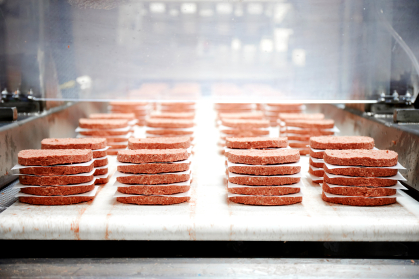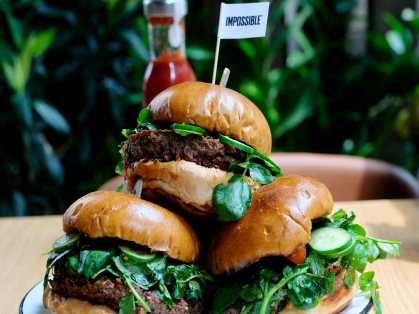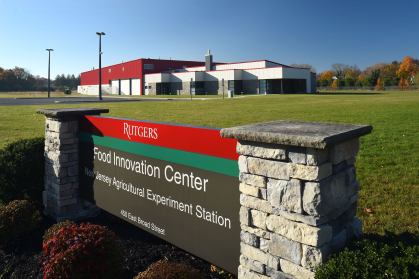How the Impossible Burger got its remarkable start at Rutgers

Chew on this. In America, a country where the average person eats around 200 pounds of meat annually and consumes at least one hamburger a week, the Impossible Burger—a meat-free alternative to the iconic ground beef patty—has catapulted itself into our collective, food-focused consciousness.
Food for thought.
The next time you’re grabbing a bite at any of the 150-plus restaurants in New Jersey alone that serve the meatless Impossible Burger, know that this disruptive delicacy came to life at Rutgers.
Impossible Foods, the company responsible for this formulated faux-meat foodstuff, has generated plenty of hype. Celebrities including Serena Williams, Bill Gates, Katy Perry, and Jay-Z have praised (and invested in) the “Impossible” concept.
With more than $750 million in funding secured, Burger King announcing its plans to serve an Impossible Whopper nationwide, and the market for meat alternatives getting hungrier—it feels like something big, perhaps even once thought impossible, is about to happen: the burger is going beefless, and people are chowing down.

Don't have a cow.
Impossible Foods founder and CEO Pat Brown has said the only customer he cares about is the “hardcore meat eater.”
Appealing to carnivores meant Brown couldn’t just settle for a new variation of the veggie burger. So, in April 2016, Impossible Foods came to the Food Innovation Center at Rutgers University to get connected to the right people in the food science and manufacturing spaces to turn the idea into a reality. The Food Innovation Center helps small businesses and entrepreneurs by providing expertise and serving as a business incubator and accelerator.
Since its residency at Rutgers, the Impossible Burger has gone through many variations. In January 2019, the company announced version 2.0; an even more true-to-meat-like formula that mimics the smoky taste and meaty mouthfeel of a beef burger while still holding up to the flames on a grill.
“It’s a vegetable-based product that looks, feels, and tastes like a hamburger. The new version is even closer to real meat,” said Nolan Lewin, director of the Food Innovation Center facility located in Piscataway, New Jersey. “The Impossible Burger patty chars and caramelizes on the outside like a regular burger would. And the smell. Most people taste through their nose. When it smells like a burger, it's going to taste even more like a burger.”
The not-so-secret "secret sauce."
What makes the Impossible Burger taste so, well, impossibly beeflike is the patented use of a compound called heme. Heme is a molecule found in every living plant and animal. It’s what makes meat taste like meat—that unmistakable “bloody” taste you get when you bite into a burger—and people have been craving it since the dawn of humanity. Impossible Foods discovered how to create a plant-based heme made through the fermentation of genetically engineered yeast.
“They knew there was a ‘secret sauce’ out there to get the flavor profile they were looking for,” said Lewin. After they found it, Rutgers helped them produce it to scale and bring it to market.

Breaking down barriers, burger by burger.
The Food Innovation Center—which is staffed by a team of food industry veterans—helped connect Impossible Foods with engineers to spec-out manufacturing equipment and with the food technologists and food safety and processing experts required to get its operation off the ground.
“When you put together a group of people with our kind of network you’re going to be connected to anyone in the industry,” Lewin said.
Because the Food Innovation Center is inspected by the USDA and FDA, food produced at the facility can be sold directly to wholesale and retail customers. The company’s go-to-market strategy was to get the Impossible Burger into the hands of chefs at high profile restaurants in New York City and the surrounding region. In July 2016, the Impossible Burger made its public debut on the menu at one of David Chang’s celebrated Momofuku restaurants in Manhattan. The plan worked, and before long the Impossible Burger was appearing on menus at destination restaurants around the country.
When you put together a group of people with our kind of network you’re going to be connected to anyone in the industry.
Move over, meat lovers.
After just two years incubating the idea and producing small batches of Impossible Burgers from a 2,000-square-foot refrigerated room at the Food Innovation Center’s Bridgeton, New Jersey, location, the company moved its operations out west to a large-scale manufacturing center in Oakland, California.
“The knowledge and experience Impossible Foods gained by working with manufacturing experts at the Food Innovation Center informed the design of the west coast facility,” said Diane Holtaway, the center’s associate director of marketing.
Impossible Foods has experienced exponential growth from the time it started producing prototypes at the Food Innovation Center and delivering to regional restaurants, to today, when the company’s flagship Impossible Burger is on the menu at more than 7,000 restaurants worldwide, and soon, at a grocery store near you.
Where's the beef?
Now, the demand for Impossible Burgers is so high that the company had to add a third shift, recruit volunteers from other departments to staff the production lines, and scramble to expand its facilities. Investment firm Barclays estimates plant-based alternative meats could become a $140 billion industry over the next decade.
With the Impossible Burger success story becoming more widespread, the Food Innovation Center is regularly being approached by companies who “want to be the next Impossible,” Lewin said. But if Impossible Foods is a case study on a breakthrough success, its footsteps won’t be easy to follow.
“You usually don’t see these kinds of companies grow into this sort of disruptive force,” he said. “The fact that they made something so close to a real meat hamburger is really what sets it apart.”
>>Learn more about next-level food ingenuity happening at Rutgers by visiting the Food Innovation Center.
Article first published June 14, 2019. Produced by James Foley, Rutgers University Communications and Marketing.